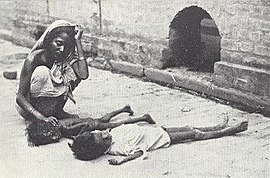Bengal famine of 1943
The Bengal famine of 1943 was a famine in the Bengal province of British India during World War II. Between 2.1 and 3 million people died in the famine.[2][3] They died mainly of starvation, malaria, and not having the right health care.
| Bengal famine of 1943 | |
|---|---|
 From the photo used in The Statesman on 22 August 1943 showing people in famine in Calcutta. | |
| Country | British India |
| Location | [1] |
| Period | 1943–1944 |
| Total deaths | Estimated 2.2 to 3 million in Bengal alone |
Historians usually say that the famine was caused by policies by the British government at the time. Food prices rose because of war-related buying and became too expensive for poor people.[4] The region of Bengal in India suffered a devastating famine from 1940 to 1943. Some of the key reasons for this famine are:[5][6]
- British export of food and material for the war in Europe;
- Japanese invasion of Burma which cut off food and other essential supplies to the region;
- British denial orders destroying essential food transportation throughout the Eastern region;
- British banned transfer of grain from other provinces, turning down offers of grain from Australia;
- mismanagement by British Indian regional governments;
- constructing 900 airfields (2,000 acres (810 ha) each) taking that huge amount of land out of agriculture in a time of the people food need;
- price inflation caused by war production
- increase in demand partially as a result of refugees from Burma and Bengal.
The British government denied an urgent request from Leopold Amery, the Indian secretary of state, and Archibald Wavell, the Viceroy of India, to stop exports of food from Bengal in order that it might be used for famine relief. Winston Churchill, then prime minister, dismissed these requests in a fashion that Amery regarded as "Hitler-like," by asking why, if the famine was so horrible, Gandhi had not yet died of starvation.[7]
The famine caused men to sell their farms and find work somewhere else. Families were made homeless and starving. Many had to move to cities like Calcutta to look for help.[8]Some scholars say that small famines happen naturally but that large ones have man-made causes like war.[4]
References
change- ↑ Maharatna 1992, pp. 320–333.
- ↑ Maharatna (1996, pp. 214–231)
- ↑ Dyson & Maharatna (1991)
- ↑ 4.0 4.1 A. Sen 1976; A. Sen 1981a; Ó Gráda 2015, p. 90.
- ↑ Mukerjee, Madhusree (2010). Churchill's secret war: the British empire and the ravaging of India during World War II. New York: Basic Books. ISBN 978-0-465-00201-6.
- ↑ Khan, Yasmin (2015). India at war: the subcontinent and the Second World War. New York: Oxford University Press. ISBN 978-0-19-975349-9. Retrieved 2023-08-31.
- ↑ Mishra, Pankaj (6 August 2007). "Exit Wounds". Archived from the original on 6 July 2014. Retrieved 21 April 2019 – via www.newyorker.com.
- ↑ Greenough, Paul (1980). Indian famines and peasant victims: the case of Bengal in 1943-44. pp. 227–228.